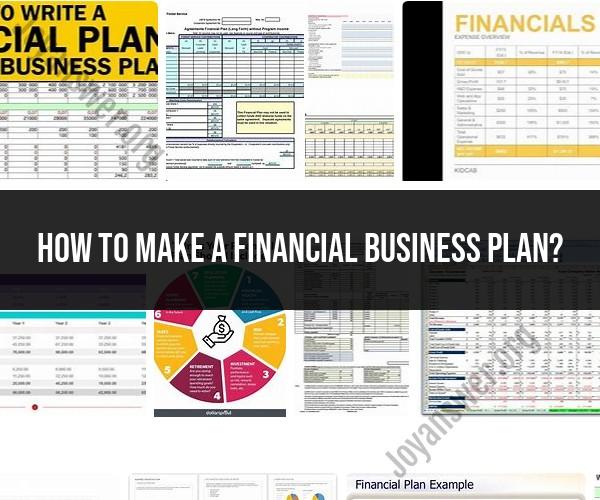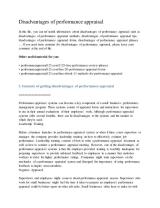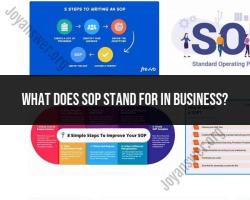How to make a financial business plan?
Creating a financial business plan is essential for the success and sustainability of your business. It provides a roadmap for managing your finances, attracting investors, and achieving your financial goals. Here's a step-by-step guide on how to make a financial business plan:
1. Executive Summary:
- Start with an executive summary that provides an overview of your business, its mission, vision, and key financial objectives.
- Summarize the main points of your financial plan, such as revenue projections, funding requirements, and profitability goals.
2. Company Description:
- Describe your business, its history, and its products or services.
- Explain your unique value proposition and target market.
3. Market Analysis:
- Analyze the industry and market trends relevant to your business.
- Identify your competitors and assess their financial performance.
- Define your target market and explain your market strategy.
4. Organizational Structure:
- Outline the structure of your organization, including key management roles and responsibilities.
- Include an organizational chart if applicable.
5. Products or Services:
- Detail your products or services, including pricing strategies.
- Explain how your offerings meet customer needs and generate revenue.
6. Sales and Marketing Strategy:
- Describe your sales and marketing approach.
- Include sales forecasts and customer acquisition strategies.
7. Funding Requirements:
- Specify your funding needs, including startup capital and ongoing financing.
- Detail how you plan to use the funds.
8. Financial Projections:
- Create detailed financial projections, including income statements, cash flow statements, and balance sheets.
- Include revenue forecasts, expense estimates, and profit margins.
- Project your financials for at least the first three to five years.
9. Break-Even Analysis:
- Calculate your break-even point, which is the level of sales at which your business covers all its expenses.
- Identify when you expect to reach this point.
10. Risk Assessment:
- Identify potential financial risks and challenges your business may face.
- Develop strategies to mitigate these risks.
11. Funding Strategy:
- Explain how you plan to secure financing, whether through equity investment, loans, or other sources.
- Describe your investor pitch and how you will attract investors.
12. Exit Strategy:
- If applicable, outline your exit strategy, such as selling the business or going public.
- Explain how this strategy aligns with your financial goals.
13. Appendices:
- Include any supporting documents or appendices, such as resumes of key team members, market research data, and additional financial information.
14. Review and Refine:
- Review and refine your financial business plan regularly to ensure it aligns with your business's actual performance and changing circumstances.
- Seek feedback from mentors, advisors, or industry experts.
15. Seek Professional Help:
- Consider consulting with a financial advisor or business consultant to help you create a comprehensive and accurate financial business plan.
Remember that a financial business plan is a dynamic document that should adapt to the evolving needs of your business. Regularly revisiting and updating your plan can help you stay on track toward your financial goals and respond effectively to changing market conditions.
Crafting a Financial Business Plan: Step-by-Step Guide
A financial business plan is a roadmap for your business's financial future. It outlines your business goals and how you plan to achieve them, and it provides a detailed overview of your financial projections.
Here is a step-by-step guide to crafting a financial business plan:
- Executive summary: This section should provide a high-level overview of your business plan, including your business goals, strategies, and financial projections.
- Company description: This section should provide a detailed description of your business, including your products or services, target market, and competitive landscape.
- Market analysis: This section should provide an overview of the market in which you operate, including the size of the market, trends, and growth opportunities.
- Business strategy: This section should describe your business strategy, including your marketing plan, sales strategy, and operations plan.
- Management team: This section should introduce your management team and highlight their skills and experience.
- Financial projections: This section should include your financial projections for the next three to five years, including income statements, balance sheets, and cash flow statements.
Financial Planning for Business Success: Creating a Strategic Plan
Financial planning is an essential part of any successful business. A well-crafted financial plan can help you to:
- Set realistic business goals
- Make informed financial decisions
- Track your progress and make adjustments as needed
- Attract investors and lenders
When creating a financial plan, it is important to consider all aspects of your business, including your revenue, expenses, and cash flow. You should also develop a strategic plan that outlines your business goals and how you plan to achieve them.
Business Finance Strategy: Building a Comprehensive Financial Plan
Your business finance strategy should be tailored to your specific business goals. However, there are some general principles that can be applied to all financial plans:
- Set realistic goals: Your business goals should be achievable and measurable.
- Make sound financial decisions: When making financial decisions, be sure to consider the long-term impact on your business.
- Track your progress: Regularly track your financial performance and make adjustments to your plan as needed.
- Attract investors and lenders: A well-crafted financial plan can help you to attract investors and lenders who are willing to support your business.
Here are some tips for building a comprehensive financial plan:
- Start with your business goals: What do you want to achieve with your business? Once you know your goals, you can start to develop a plan to achieve them.
- Identify your revenue sources: How will you generate revenue? Be sure to identify all of your potential revenue streams.
- Estimate your expenses: What are your fixed and variable costs? Be sure to estimate all of your expenses as accurately as possible.
- Forecast your cash flow: Your cash flow forecast should show how much money you expect to come in and go out of your business over a period of time.
- Develop a strategic plan: Your strategic plan should outline your business goals and how you plan to achieve them.
- Seek professional help: If you need assistance developing a financial plan, consider seeking professional help from an accountant or financial advisor.
A well-crafted financial plan is an essential tool for any successful business. By following the tips above, you can create a financial plan that will help you to achieve your business goals.













